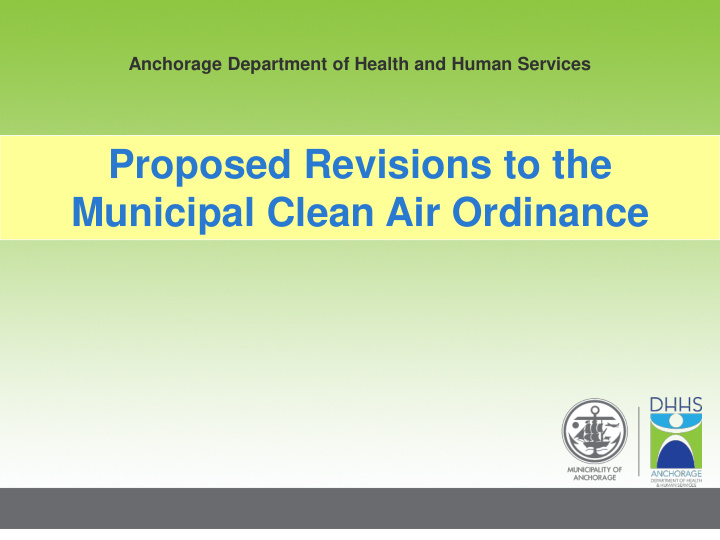



Anchorage Department of Health and Human Services Proposed Revisions to the Municipal Clean Air Ordinance YOUR LOGO Page 1
Why update the Clean Air code? • Eliminate references to the defunct South Central Clean Air Authority Commission (SCCAAC). • Revise administrative hearing and appeals procedures so that they are directed to the municipal AHO rather than the SCCAAC. • Eliminate air permitting and source registration requirements that are largely duplicative with ADEC requirements. • Make “housekeeping” changes that eliminate unnecessary and antiquated provisions in the current code. • Add new opacity requirements for wood stoves and fireplaces that are enforceable and help Anchorage avoid possible violations of the federal air quality standard for fine particulate (PM-2.5). • Simplify by consolidating the clean air code into one chapter in Title 15 instead of two. YOUR LOGO Page 2
What was the SCCAAC? • Created in 1970’s to address regional air quality issues common to Kenai, Mat Su and Anchorage. Originally conceived as a tri-borough commission until Kenai dropped out. • In 1980’s the SCCAAC included elected officials from the Municipality of Anchorage and the Mat Su Borough. The Commission addressed topics such as: • Open burning at Point MacKenzie (for clearing dairy land) • Expansion of I/M Program requirements for Mat Su residents that regularly commuted to Anchorage. • Last meeting took place in 1992. • Sunsetted by the Anchorage Assembly in October 2011. YOUR LOGO Page 3
SCCAAC responsibilities in current code • Hear appeals concerning decisions of the director concerning applications for variances, permits or other entitlements, appeals from compliance orders and other decisions of the director. • Advise the mayors and assemblies of member governments regarding enactment or revision of legislation affecting air quality within the authority. • Hold public hearings for administration and enforcement of rules and regulations of the authority, member government ordinances and state law. • Issue orders in the exercise of appellate jurisdiction as necessary. YOUR LOGO Page 4
Proposed code will move appellate jurisdiction from the SCCAAC to the Municipal AHO • Appeals and administrative hearings will be handled in accordance with AMC 3.60 – Administrative Adjudication. These procedures generally apply to all quasi-judicial proceedings and administrative hearings in the municipality. • Title 14 establishes an administrative hearings officer (AHO) to hear appeals of enforcements action and other matters referred for administrative adjudication under AMC 3.60. • The AHO would fill the role of the SCCAAC under the proposed revisions to the Clean Air Code. YOUR LOGO Page 5
Proposed code will eliminate municipal air permitting and source registration requirements • ADEC already permits the vast majority of air contaminant sources that would require municipal air permits. • Only a handful of sources within the municipality require air permits. It would be inefficient to assume permitting responsibility from ADEC. • DHHS does not currently have the staff or expertise required to effectively review and issue air quality permits. • Eliminating municipal permitting and source registration requirements will mean that two facilities (Alaska Railroad and Entech Incineration) will no longer be required to obtain municipal permits. YOUR LOGO Page 6
Several sections of the code have been eliminated because they are unnecessary or the responsibility of ADEC. • Municipal attorney has advised that several sections are redundant because concern is addressed elsewhere in the code or are simply unneeded. • We have deleted sections pertaining to stationary source emission standards and source testing requirements because they have never been applied, the standards are antiquated, and are covered by more up-to-date standards in state regulation which ADEC can enforce. YOUR LOGO Page 7
New code will add new opacity limitations for wood stoves and fireplaces. YOUR LOGO Page 8
Current code is subjective and difficult to enforce 15.35.070 Stationary source emissions--Other emission limitations. A. No person shall cause, allow or permit the emission of any air contaminant or water vapor, including but not limited to odorous matter, that tends to be injurious to or adversely affects human health, safety or welfare, animal or plant life, or property or interferes with the normal use and enjoyment of life, property or business. YOUR LOGO Page 9
Proposed code will set a 20% opacity limit for woodstoves and fireplaces • Current code already includes this Anchorage PM-2.5 by Year same opacity limit for outdoor wood 40 Federal Air Quality Standard boilers. 35 30 28 25 • 20% opacity limit is fairly common in PM-2.5 (ug/m3) 25 23 many communities; Fairbanks recently 19 20 18 17 16 adopted a 20% limit like the one DHHS 15 is proposing. The State of Alaska is 10 considering a similar limit but has not 5 yet adopted. 0 2009 2010 2011 2012 2013 2014 2015 • We believe that the opacity limit provides an important tool for preventing future violations of the federal air quality standard for fine particulate or PM-2.5. YOUR LOGO Page 10
We are requesting your endorsement of these proposed code revisions The proposed code revisions will: • Resolve issue of who will hear hearings and appeals. • Eliminate duplicative permitting and source registration requirements. • Provide a new enforcement tool to address citizen complaints about excess smoke from wood stoves and fireplace and help prevent future violations of federal air quality standards. • Simplify and streamline the code. YOUR LOGO Page 11
Recommend
More recommend